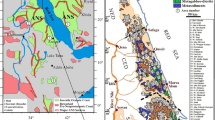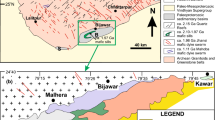Abstract
The Habo alkaline intrusion, which is located in the south of the Sanjiang area, Yunnan Province, China, is a typical Cenozoic alkaline intrusion. There are a series of small to medium-sized Au and Pb–(Zn) deposits around this intrusion. Those deposits are spatially associated with the Habo alkaline intrusion. (1) The δ34S values of sulfides from Au deposits range from −1.91 ‰ to 2.69 ‰, which are similar to those of Pb–(Zn) deposits (−3.82 ‰ to −0.05 ‰) and both indicate a much greater contribution from magma. (2) The Habo alkaline intrusion has relatively homogeneous Pb isotopic compositions with 206Pb/204Pb ranging from 18.608 to 18.761, 207Pb/204Pb from 15.572 to 15.722 and 208Pb/204Pb from 38.599 to 39.110. These Pb isotope ratios are similar to those of Au deposits, whose 206Pb/204Pb range from 18.564 to 18.734, 207Pb/204Pb from 15.582 to 15.738 and 208Pb/204Pb from 38.592 to 39.319. Pb ratios in both the intrusion and Au deposits suggest that Pb mainly derived from the depth, probably represents a mixture of mantle and crust. Pb–(Zn) deposits, however, show a decentralized trait, and most of them are similar to that of the alkaline intrusion with 206Pb/204Pb ranging from 18.523 to 18.648, 207Pb/204Pb from 15.599 to 15.802, and 208Pb/204Pb from 38.659 to 39.206. (3) In the plumbotectonic diagram 207Pb/204Pb versus 206Pb/204Pb, almost all of Au and Pb–(Zn) deposits have the same projection area with the Habo alkaline intrusion, which indicates that those deposits almost share the same source with the alkaline intrusion. (4) Isotopic age of the Habo alkaline intrusion is 36–33 Ma, which is similar to that of Beiya, whose ore-related alkaline porphyries age is 38–31 Ma and molybdenite Re–Os age is 36.9 Ma. Therefore, along with S–Pb isotope traits, we suggest that the Habo Au and Pb–(Zn) deposits should be typically Ailaoshan-Red RiverCenozoicalkaline-related deposits and ore-forming ages of these deposits should be later than that of the Habo alkaline intrusion.







Similar content being viewed by others
References
Basuki NI, Taylor BE, Spooner ETC (2008) Sulfur isotope evidence for thermochemical reduction of dissolved sulfate in Mississippi valley type zinc—lead mineralization, Bongara area, northern Peru. Econ Geol 103:183–799
Bi XW, Hu RZ (1998) REE geochemistry of ore-forming fluids from Ailaoshan gold metallogenic belt. Geol Rev 44(3):48–87 (in Chinese with English abstract)
Bi XW, Hu RZ, Peng JT (2005) The geochemistry traits of alkaline-rich porphyry intrusions from Yaoan and Machangqing. Acta Pet Sin 21(1):113–124 (in Chinese with English abstract)
Canals A, Cardellach E (1997) Ore lead and sulphur isotope patternfrom the low-temperature veins of the Calalonian Coastal Ranges (NE Spain). Miner Depos 32:243–249
Chaussidon M, Lorand JP (1990) Sulfur isotope composition of orogenic spinel lherzolite massifs from Ariege (North-Eastern Pyrenees, France): an ion microprobe study. Geochim Cosmochim Acta 54(10):2835–2846
Chen YC (1994) Metallogenic series of ore deposits. Earth Sci Front 1(3–4):105–118 (in Chinese with English abstract)
Chen YC (1997) Present situation and trend of research on metallogenic series of ore deposits. Geol Prospect 33(1):21–25 (in Chinese with English abstract)
Cheng YQ, Chen YC, Zhao YM (1979) Preliminary discussion on the problems of minerogenetic series of mineral deposits. Bull Chin Acad Geol Sci 1(1):32–58 (in Chinese with English abstract)
Cheng YQ, Chen YC, Zhao YM, Song TR (1983) Further discussion on the problems of minerogenetic series of mineral deposits. Bull Chin Acad Geol Sci 6:1–64 (in Chinese with English abstract)
Chung SL, Lee TY, Lo CH et al (1997) Intraplate extension prior to continental extrusion along the Ailaoshan-Red River shear zone. Geology 25:311–314
He WX, Mo XX, Yu XH, He ZH et al (2013) Zircon U–Pb and Molybdenite Re–Os dating for the Beiya Au polymetallic deposit in the western Yunnan Province and its geological significance. Acta Pet Sin 29:1301–1310 (in Chinese with English abstract)
Hou ZQ, Ma HW, Khin Z, Zhang YQ (2003) The Himalayan Yulong porphyry copper belt: produced by largescale strike- slip faulting at Eastern Tibet. Econ Geol 98:125–145
Hou ZQ, Pan GT, Wang AJ (2006) Qinghai-Tibet plateau collision orogen: late II collision conversion mineralization. Miner Depos 25(5):521–543 (in Chinese with English abstract)
Hou ZQ, Zaw K, Pan GT, Mo XX, Xu Q, Hu YZ, Li XZ (2007) The Sanjiang Tethyan metallogenesis in S.W.China: tectonic setting, metallogenic epoch and deposit type. Ore Geol Rev 31(1–4):48–87
Hu RZ, Burnard PG, Bi XW (2004) Helium and argon isotope geochemistry of alkaline intrusion-as sociated gold and copper deposits along the Red River-Jinshajiang fault belt, SW China. Chem Geol 203:305–317
Ji JQ, Zhong DL, Zhang LS (2000) Kinematics and dating of Cenozoic strike-slip faults in the Tengchong area, west Yunnan: implications for the block movement in the southeastern Tibet Plateau. Chin J Geol 35(3):336–349
Kan YS (2013) Geological and geochemical characteristics of Beiya gold deposits. Dissertation, China University of Geosciences, Beijing (in Chinese with English abstract)
Li Y (2009) The metallogenic geochemistry and significance of Prospecting of gold polymetallic ore concentration area in Beiya in western Yunnan Province. Dissertation, China University of Geosciences, Beijing (in Chinese with English abstract)
Li L, Zheng YF, Zhou JB (2001) The lead isotope evolution model of Chinese mainland. Acta Petrol Sin 17(1):61–68 (in Chinese with English abstract)
Ohmoto H (1972) Systematics of sulfur and carbon isotopes in hydrothermal ore deposits. Econ Geol 67:551–579
Ohmoto H (1986) Stable isotope geochemistry of ore deposits. Rev Mineral 6:491–559
Ohmoto H, Kaiser CJ, Geer KA (1990) Systematics of sulphur isotopes in recent marine sediments and ancient sediment-hosted base metal deposits. In: Herbert HK, Ho SE (eds) Stable isotopes and Fluid Processes in Mineralization. Geology Department & University Extension, The University of Western Australia, Perth, pp 70–120
Rey RO, Sawkins FJ (1974) Fluid inclusion and stable isotope studies on Casapalca Ag–Pb–Zn–Cu deposit, Central-Andes. Peru Econ Geol 69(2):181–205
Seal RR (2006) Sulfur isotope geochemistry of sulfide minerals. R Miner Geochem 61:633–677
Turner S, Arnaud N, Liu JQ (1996) Post- collision, shoshonitic volcanism on the Tibetan plateau: implications for convective thinning of the lithosphere and the source of ocean island basalts. J Pet 37:45–71
Wang EQ, Burchfiel BC (1997) Interpretation of Cenozoic tectonics in the right-lateral accommodation zone between the Ailaoshan shear zone and the eastern Himalayan syntaxis. Int Geo Rev 39:191–219
Wang JH, Yin A, Harrison TM (2001) A tectonic model for Cenozoic igneous activities in the eastern Indo-Asian collision zone. Earth Planet Sci Lett 188:123–133
Wang DH, Qu WJ, Li ZW (2004) The principal metallogenic epoch of Porphyry Cu–Mo deposits from Jing Sha River-Red River metallogenic belt: Re–Os isotope dating. Sci China (Ser D) 34(4):345–349 (in Chinese with English abstract)
Wu KH, Hu RZ, Bi XW, Zhang Q, Peng JT (2004) The explaining of upper mantle lead isotope evolution model and lead isotope compositions from alkaline porphyry of western Yunnan. China. Acta Geosci Sin 25(2):263–270 (in Chinese with English abstract)
Yin A, Harrison TM (2000) Geologic evolution of the Himalayan-Tibetan orogen. J Ann Rev Earth Planet Sci 28:211–280
Zartman RE, Doe BR (1981) Plumbotectonics-the model. Tectonophysics 75:135–162
Zhai YS, Xiong YL (1987) On the structure of the metallogenic series. Earth Sci J Wuhan Coll Geol 12(4):375–380 (in Chinese with English abstract)
Zhang YQ, Xie YW (1997) The geochronology and characteristics of Nd, Sm isotope of Aailaoshan-Jingshajiang alkali-rich intrusive rocks. Sci China (Ser D) 27(4):289–293
Zhang YQ, Xie YW, Tu GZ (1987) A preliminary study on the relations between Ailaoshan-Jinshajiang River alkaline-rich intrusion and fault structures. Acta Pet Sin 3(1):17–25 (in Chinese with English abstract)
Zhang Q, Pan JY, Shao SX (2000) An interpretation of ore sources from lead isotopic compositions of some ore deposits in China. Geochimica 29(3):231–238 (in Chinese with English abstract)
Zhang B, Zhang JJ, Zhong DL (2009) Strain and kinematic vorticity analysis: an indicator for sinistral transpressional strain-partitioning along the Lancangjiang shear zone, western Yunnan China. Sci China 52(5):602–618
Zhao DK, Wang HS, Xue HY (2009) Analysis of the geology traits and genetics of the Habo Cu–Mo–Au deposit, Yunna Chinan. Acta Geol Sin 33(3):230–234 (in Chinese with English abstract)
Zheng YF, Hoefs JC (1993) Effects of mineral precipitation on the sulfur isotope composition of hydrothermal solutions. Chem Geol 105(4):259–269
Zhou JX, Huang ZL, Zhou GF, Jin ZG, Li XB, Ding W, Gu J (2010) Sources of the ore metals of the Tianqiao Pb–Zn deposit in Northwestern Guizhou Province: constraints form S, Pb isotope and REE Geochemistry. Geol Rev 56(4):513–524 (in Chinese with English abstract)
Zhou JX, Huang ZL, Bao GP (2013a) Geological and sulfur-lead-strontium isotopic studies of the Shaojiwan Pb–Zn deposit, southwest China: implications for the origin of hydrothermal fluids. J Geochem Explor 128:51–61
Zhou JX, Huang ZL, Yan ZF (2013b) The origin of the Maozu carbonate-hosted Pb–Zn deposit, southwest China: constrained by C–O–S–Pb isotopic compositions and Sm–Nd isotopic age. J Asian Earth Sci 73:39–47
Zhou JX, Huang ZL, Zhou MF, Zhu XK, Muchez P (2014) Zinc, Sulfur, and lead isotopic variations in carbonate-hosted Pb–Zn sulfide deposits, southwest China. Ore Geol Rev 58:41–54
Zhou JX, Huang ZL, Dou S, Cui YL, Ye L, Li B, Gan T, Sun HR (2016) Origin of the Luping Pb deposit in the Beiya area, Yunnan Province, SW China: constraints from geology, isotope geochemistry. Ore Geol Rev 72:179–190
Zhu BQ (1995) The mapping of geochemical provinces in China based on Pb isotopes. J Geochem Explor 55:171–181
Zhu BQ (1998) Concurrently discussed the crust-mantle evolution of Chinese continental. In: Coleman RG, Wang XM (eds) Theories and applications of isotopic system in geosciences. Science Press, Beijing, p 221
Zhu XP, Mo XX, White NC (2009) Research of ore geology and ore-forming background from the Habo Cu–Mo–Au deposit, Yunnan China. Acta Geol Sin 83(12):1915–1928 (in Chinese with English abstract)
Zhu XP, Mo XX, White NC, Zhang B, Sun MX, Wang SX, Zhao Y (2013) Petrogenesis and metallogenic setting of the Habo porphyry Cu–(Mo–Au) deposit. Yunnan, China. J Asian Earth Sci 66:188–203
Acknowledgments
This study thanks Yunnan No. 2 Geological Survey for providing plenty of field data. We are also grateful to State Key Laboratory of Environmental Geochemistry, Institute of Geochemistry, Chinese Academy of Sciences and Wuhan Geological Survey Center, Chinese geological Survey for providing technical supports on isotopic analysis.
Author information
Authors and Affiliations
Corresponding author
Ethics declarations
Conflict of interest
There is no Conflict of interest.
Rights and permissions
About this article
Cite this article
Meng, Z., Zhang, Q., Ye, L. et al. The genetic relationship between Habo alkaline intrusion and its surrounding deposits, Yunnan Province, China: geological and S–Pb isotopic evidences. Acta Geochim 35, 391–407 (2016). https://doi.org/10.1007/s11631-016-0124-4
Received:
Revised:
Accepted:
Published:
Issue Date:
DOI: https://doi.org/10.1007/s11631-016-0124-4




